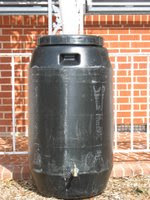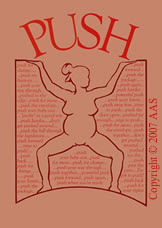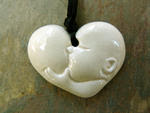I attended a birth on July 4th. You guessed it; of course, it was a homebirth. I s'posed that the baby might be one of the very few babies born on the holiday during 2007. Most of the babies due anywhere near were induced in order to have the holiday free. Imagine what havoc the Wednesday holiday created for obstetricians --- getting births in on Monday and Tuesday. I bet that was tricky. Do you suppose that they just induced the week before to make sure the weekend was free as well? You can go to your local hospital website and track births. I started doing that two years ago when my cousin's son had a baby in St Louis, MO. My mother couldn't pull up the picture and I was helping her. DAMN!!! I noticed immediately no babies on the 4th and a spike in the days before. I got to looking and DAMN! again! BIG drop in the numbers of birth on Saturday and Sunday and every holiday. *#($(& $(&#(* (*#&(*. Makes me angry to think about how obstetricians are given free license to do whatever they want even when the science shows the danger and consequences to women and babies (induction, then the needed epidural ANESTHESIA, and then surgical births they lead to.) I wonder how NICU census numbers range near holidays.
ANYWAY, back to sweeter things ..... the homebirth I attended. Baby number four. Second homebirth. The first two were cesarean births. (I could get into that, but will save it.) The midwife for the birth was an Amish midwife who was two hours away. I was seventy some miles. The baby was "over due" and not much happening. The mother woke in labor about 6:30 am and she called me by 7. I headed out about 8 ish to drive the 78 mile trip. I arrived about eight minutes before the baby was born at 9:30 am, and the midwife was about four minutes behind me.
No one answered the door and I crept in quietly, whispering, "Haaalllooo." Grandma stuck her head out of the bathroom and said, "We're in transition!" I was unwrapping video camera cords as I approached. I looked in and thought, "Ah, you are way past transition." Baby's head was crowning. Grandma said, in a panic now, "Have you been to a birth before?" I was there to video the birth for my documentary AND to support the baby and mom to have minimal disruptions and to do the self-attachment sequence. She said, "I don't know if this is normal -- I have never seen it from this end." (She did two homebirths too.) I noticed that it was only the dad sitting on the side of the tub supporting the mother, and the grandma. No midwife. A flushed and relieved and now-panick feeling Grandmother moved aside for me to "take over." I was still fumbling with the camera cord and my camera battery seemed uncharged. The father said the electricity had gone out. As I put the camera aside, I said to the grandmother, "It is, (normal). She's crowning." To the mother I said, "You're doing great. I see baby's head. " To Grandma I asked, "Do you have gloves?" My fleeting thought was a plan to support the mother to catch her own baby and to get ready to activate a transport. I was grateful I'd taken neonatal resuscitation certification with Karen Strange in January and had just reviewed it. Country birth. Amish midwife. Seemed like a good thing to do. I was more grateful it wasn't necessary.
In that couple of minutes, between the crowning head contraction and the next one that pushed baby out, while I was thinkin' 'bout what to do about no gloves (and blood and fecal matter), the midwife arrived. She walked into the bathroom, pulling on her gloves. I moved to the side by grandma who had moved aside for me. The midwife leaned down between us and the tub (like we were playing Twister -- bathrooms aren't made for five people and one birthing a baby) and she caught the baby. Easily. Peacefully. Gently. It could not have been orchestrated more perfectly and beautifully if we'd tried it. Minutes, literally. If I had stopped along the way to go to the bathroom, or if I'd gotten behind a slow vehicle, or if I'd hit the lights wrong going through town, or stopped to talk with my friend when I dropped off something to her, I would have missed it. Three hours of labor were basically transition. I left about six hours later and I went to my fourth of July party.
That night my father was transported two hours by ambulance from the rural area in other direction to Columbia. Rural Missourians have next to zero options for ANY kind of medical care, birth to elderly. Today I finally got to have a long talk with the happy, rested mama. I told her (I'd been awed by this thought) that her baby is the least traumatized human being I have ever seen. She was so well cared for in the first hours of her life, and in a quiet environment where no one hurt her. She did cry and cry for twenty minutes, and I believe it was about the pressure on her head. Going fast is very painful for the baby.
She had not one sonogram, or vaginal check, or monitoring between contractions. No shots, no scrubbing or bath. Weighing done at one hour just before the midwife left . Otherwise, baby in mama, daddy, or Grandma's arms, and mine briefly in the first minutes of her life. Only people the mother trusts and chose. I held her briefly during the first moments of her life while the mother repositioned herself on her knees, then to support self-attachment, and to carry her to the other room where mother wanted to sit after two hours. Baby's head was not constantly poked and prodded as in a birth I attended recently at home where baby was monitored in between every contraction. So disrupted. Why? Because the doctor has to document and protect herself. Not from the parents necessarily, but from the system that will go after her should anything happen. The mother held the baby while she was still on her knees, holding her, talking to her, touching her .... what she wanted that she'd missed in the first births. She held the baby below the level of the placenta -- just as Dr. Morley says is optimal (http://www.cordclamp.com/). When the cord was cut it was white -- indicating transfer of blood and cessation of pulsing. The midwife was holding the baby. The father softly said, "Give her to me" and the midwife did immediately. It was SO BEAUTIFUL --- SO the way it is supposed to be. Isabella is HIS daughter. It's his home, and mama is his wife. There was zero resistance from the midwife. She trusted the woman's body to care for the baby during labor and birth, and she trusts a father to care for his baby in the first minutes of life. There is nothing like seeing this.
Later when the electricity was back on I got video of him cleaning the bathroom and working in the kitchen. It was amazing to watch -- he was instinctual. While mama and baby cuddled, touched, and nursed he would go do caretaking chores --- getting the laundry started, making food. He was circle around and check on his baby and wife. It was like watching the male of an animal species caring for his baby and partner.
Welcome to the world, little one, little Isabella. She is so cute. She did self attach by the way. She did it her way and in her timing, of course. Self-attachment is so awesome to watch. The baby at the previous birth I videotapped also got to self-attach. I stopped the midwife from interfering -- the baby was crying and struggling, as they do and are supposed to. Baby and mother, just like in labor and birth, interacting together. It's ok for the baby to struggle with soft, gentle guidance and support from mother -- to attach at her breast. Welcome, Phoenix. Sweet, amazing baby.
So cool. SO COOL.
The Other Side of the Glass
Part One was officially released June 2013 in digital distribution format.
To purchase to to www.theothersideoftheglass.com
If you were a donor and want to download your copy send an email to theothersideoftheglassfilm@gmail.com.
The trailer
Sunday, July 08, 2007
Homebirth Attended by Amish midwife
Labels:
Fourth of July,
home birth,
Instinctual fathering,
MO Amish
Subscribe to:
Post Comments (Atom)
"Soft is the heart of a child. Do not harden it."
A public awareness reminder that things that happen behind the scenes, out of our sight, aren't always as rosy as we might think them to be. Perhaps its a restaurant cook who accidentally drops your burger
on the floor before placing it on the bun and serving it to you. Here it's an overworked apathetic (pathetic) nurse giving my newborn daughter her first bath.
Please comment and rate this video, so as to insure that it is viewed as widely as possible, perhaps to prevent other such abuse. -- The mother who posted this YouTube. How NOT to wash a baby on YouTube
Are you going to try to tell me that "babies don't remember?" There is no difference to this baby's experience and the imprinting of her nervous system/brain and one that is held and cleaned by the mother or father either at the hospital or at home?
By the way, this is probably NOT the baby's first bath. The nurse is ungloved. Medical staff protocol is that they can't handle a baby ungloved until is has been bathed (scrubbed if you've seen it) because the baby is a BIO-HAZARD -- for them. Never mind that the bio-hazard IS the baby's first line of defense against hospital germs.
Missouri Senator Louden Speaks
Finally, A Birth Film for Fathers
Part One of the "The Other Side of the Glass: Finally, A Birth Film for and about Men" was released June, 2013.
Through presentation of the current research and stories of fathers, the routine use of interventions are questioned. How we protect and support the physiological need of the human newborn attachment sequence is the foundation for creating safe birth wherever birth happens.
Based on knowing that babies are sentient beings and the experience of birth is remembered in the body, mind, and soul, fathers are asked to research for themselves what is best for their partner and baby and to prepare to protect their baby.
The film is designed for midwives, doulas, and couples, particularly fathers to work with their caregivers. Doctors and nurses in the medical environment are asked to "be kind" to the laboring, birthing baby, and newborn. They are called to be accountable for doing what science has been so clear about for decades. The mother-baby relationship is core for life. Doctors and nurses and hospital caregivers and administrators are asked to create protocols that protect the mother-baby relationship.
Men are asked to join together to address the vagaries of the medical system that harm their partner, baby and self in the process of the most defining moments of their lives. Men are asked to begin to challenge the system BEFORE they even conceive babies as there is no way to be assured of being able to protect his loved ones once they are in the medical machine, the war zone, on the conveyor belt -- some of the ways that men describe their journey into fatherhood in the medicine culture.
Donors can email theothersideoftheglassfilm@gmail.com to get a digital copy.
Through presentation of the current research and stories of fathers, the routine use of interventions are questioned. How we protect and support the physiological need of the human newborn attachment sequence is the foundation for creating safe birth wherever birth happens.
Based on knowing that babies are sentient beings and the experience of birth is remembered in the body, mind, and soul, fathers are asked to research for themselves what is best for their partner and baby and to prepare to protect their baby.
The film is designed for midwives, doulas, and couples, particularly fathers to work with their caregivers. Doctors and nurses in the medical environment are asked to "be kind" to the laboring, birthing baby, and newborn. They are called to be accountable for doing what science has been so clear about for decades. The mother-baby relationship is core for life. Doctors and nurses and hospital caregivers and administrators are asked to create protocols that protect the mother-baby relationship.
Men are asked to join together to address the vagaries of the medical system that harm their partner, baby and self in the process of the most defining moments of their lives. Men are asked to begin to challenge the system BEFORE they even conceive babies as there is no way to be assured of being able to protect his loved ones once they are in the medical machine, the war zone, on the conveyor belt -- some of the ways that men describe their journey into fatherhood in the medicine culture.
Donors can email theothersideoftheglassfilm@gmail.com to get a digital copy.
Buy the film at www.theothersideoftheglass.com.
The film focuses on the male baby, his journey from the womb to the world and reveals healing and integrating the mother, father, and baby's wounded birth experience. The film is about the restoring of our families, society, and world through birthing loved, protected, and nurtured males (and females, of course). It's about empowering males to support the females to birth humanity safely, lovingly, and consciously.
Finally, a birth film for fathers.
The film focuses on the male baby, his journey from the womb to the world and reveals healing and integrating the mother, father, and baby's wounded birth experience. The film is about the restoring of our families, society, and world through birthing loved, protected, and nurtured males (and females, of course). It's about empowering males to support the females to birth humanity safely, lovingly, and consciously.
Finally, a birth film for fathers.
What People Are Saying About the FIlm
Well, I finally had a chance to check out the trailer and .. wow! It's nice that they're acknowledging the father has more than just cursory rights (of course mom's rights are rarely acknowledged either) and it's great that they're bringing out the impact of the experience on the newborn, but I'm really impressed that they're not shying away from the political side.
They are rightly calling what happens in every American maternity unit, every day, by its rightful name - abuse. Abuse of the newborn, abuse of the parents and their rights, abuse of the supposedly sacrosanct ethical principal of patient autonomy and the medico-legal doctrine of informed consent, which has been long ago discarded in all but name. I love it!
In the immortal words of the "shrub", "bring it on!" This film needs to be shown and if I can help facilitate or promote it, let me know.
Father in Asheville, NC
Thanks for sharing this. It was very touching to me. I thought of my brother-in-law standing on the other side of the glass when my sister had to have a C-section with her first child because the doctor was missing his golf date. I'll never forget his pacing back and forth and my realizing that he was already a father, even though he hadn't been allowed to be with his son yet.
Margaret, Columbia, MO
They are rightly calling what happens in every American maternity unit, every day, by its rightful name - abuse. Abuse of the newborn, abuse of the parents and their rights, abuse of the supposedly sacrosanct ethical principal of patient autonomy and the medico-legal doctrine of informed consent, which has been long ago discarded in all but name. I love it!
In the immortal words of the "shrub", "bring it on!" This film needs to be shown and if I can help facilitate or promote it, let me know.
Father in Asheville, NC
OMG'ess, I just saw the trailer and am in tears. This is so needed. I watch over and over and over as fathers get swallowed in the fear of hospitals birth practice. I need a tool like this to help fathers see how very vital it is for them to protect their partner and baby. I am torn apart every time I see a father stand back and chew his knuckle while his wife is essentially assaulted or his baby is left to lie there screaming.
Please send me more info!!!!
Carrie Hankins
CD(DONA), CCCE, Aspiring Midwife
720-936-3609
Thanks for sharing this. It was very touching to me. I thought of my brother-in-law standing on the other side of the glass when my sister had to have a C-section with her first child because the doctor was missing his golf date. I'll never forget his pacing back and forth and my realizing that he was already a father, even though he hadn't been allowed to be with his son yet.
Margaret, Columbia, MO
In case you don't find me here
Soon, I'll be back to heavy-duty editing and it will be quiet here again. I keep thinking this blog is winding down, and then it revives. It is so important to me.
I wish I'd kept a blog of my journey with this film this past 10 months. It's been amazing.
I have a new blog address for the film, and will keep a journal of simple reporting of the journey for the rest of the film.
www.theothersideoftheglassthefilm.blogspot.com
I'll be heading east this week to meet with a group of men. I plan to post pictures and clips on the film blog.
I'll keep up here when I can -- when I learn something juicy, outrageous, or inspiring related to making birth safer for the birthing baby.
I wish I'd kept a blog of my journey with this film this past 10 months. It's been amazing.
I have a new blog address for the film, and will keep a journal of simple reporting of the journey for the rest of the film.
www.theothersideoftheglassthefilm.blogspot.com
I'll be heading east this week to meet with a group of men. I plan to post pictures and clips on the film blog.
I'll keep up here when I can -- when I learn something juicy, outrageous, or inspiring related to making birth safer for the birthing baby.
Review of the film
Most of us were born surrounded by people who had no clue about how aware and feeling we were. This trailer triggers a lot of emotions for people if they have not considered the baby's needs and were not considered as a baby. Most of us born in the US were not. The final film will include detailed and profound information about the science-based, cutting-edge therapies for healing birth trauma.
The full film will have the interviews of a wider spectrum of professionals and fathers, and will include a third birth, at home, where the caregivers do a necessary intervention, suctioning, while being conscious of the baby.
The final version will feature OBs, RNs, CNMs, LM, CPM, Doulas, childbirth educators, pre and perinatal psychologists and trauma healing therapists, physiologists, neurologists, speech therapists and lots and lots of fathers -- will hopefully be done in early 2009.
The final version will include the science needed to advocated for delayed cord clamping, and the science that shows when a baby needs to be suctioned and addresses other interventions. Experts in conscious parenting will teach how to be present with a sentient newborn in a conscious, gentle way -- especially when administering life-saving techniques.
The goal is to keep the baby in the mother's arms so that the baby gets all of his or her placental blood and to avoid unnecessary, violating, and abusive touch and interactions. When we do that, whether at home or hospital, with doctor or midwife, the birth is safe for the father. The "trick" for birthing men and women is how to make it happen in the hospital.
The full film will have the interviews of a wider spectrum of professionals and fathers, and will include a third birth, at home, where the caregivers do a necessary intervention, suctioning, while being conscious of the baby.
The final version will feature OBs, RNs, CNMs, LM, CPM, Doulas, childbirth educators, pre and perinatal psychologists and trauma healing therapists, physiologists, neurologists, speech therapists and lots and lots of fathers -- will hopefully be done in early 2009.
The final version will include the science needed to advocated for delayed cord clamping, and the science that shows when a baby needs to be suctioned and addresses other interventions. Experts in conscious parenting will teach how to be present with a sentient newborn in a conscious, gentle way -- especially when administering life-saving techniques.
The goal is to keep the baby in the mother's arms so that the baby gets all of his or her placental blood and to avoid unnecessary, violating, and abusive touch and interactions. When we do that, whether at home or hospital, with doctor or midwife, the birth is safe for the father. The "trick" for birthing men and women is how to make it happen in the hospital.








1 comment:
Love this post, just how a birth is supposed to be, real, supported and amazing. Nothing taken from it. Simple and beautiful.
Post a Comment